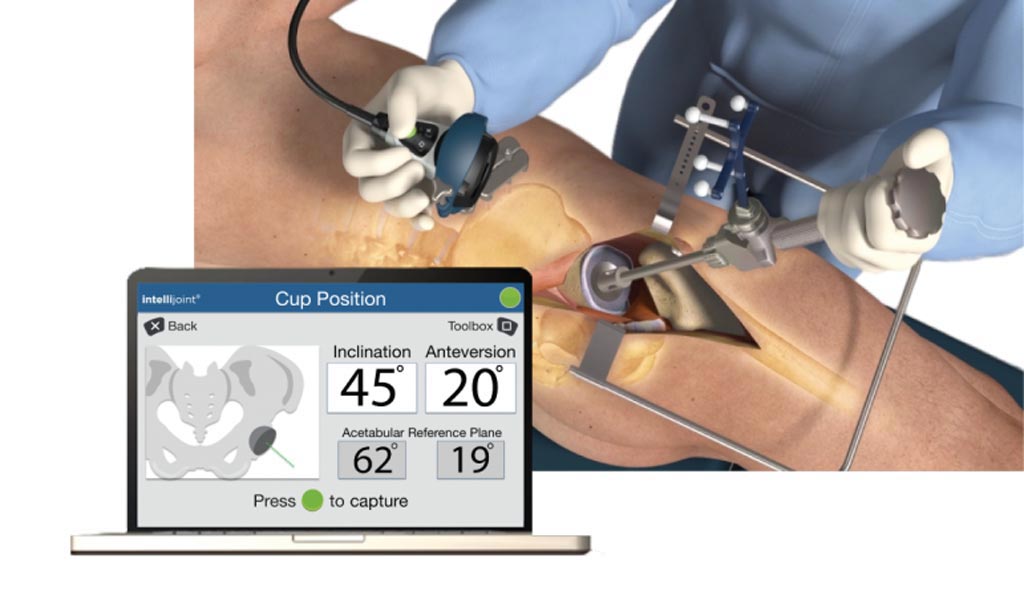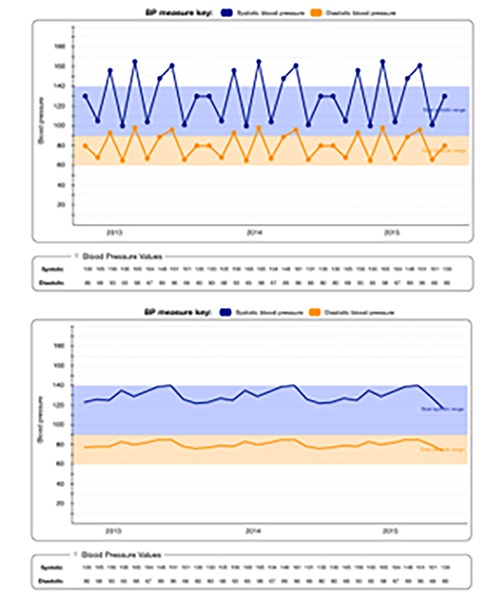Smart Navigation Systems Optimize Total Hip Arthroplasty
|
By HospiMedica International staff writers Posted on 07 Nov 2019 |

Image: An innovative mini-optical system helps ensure accurate THA (Photo courtesy of Intellijoint Surgical).
The combination of two surgeon-controlled surgical planning and guidance platforms optimizes the treatment of total hip arthroplasty (THA) procedures.
The EOS Imaging (Paris, France) hipEOS 3.0 is a three dimensional (3D) surgical planning solution that uses weight-bearing standing and sitting EOS images and 2D/3D patient-specific models and datasets to help select and position implants for the best anatomical fit in order to optimize range of motion, based on each patient’s 3D anatomy. This delivers an optimal surgical strategy while taking into consideration patient-specific factors that are key criteria for successful THA, including hip-spine relationship, leg length discrepancy, femoral offset and femoral torsion.
In the first cased performed using the new software, the surgical plan was implemented using Intellijoint Surgical (Waterloo, ON, Canada) HIP, a mini-optical navigation system that provides accurate intraoperative alignment information. The combination of the two platforms enables surgeons to select the best implant type and size, the ideal position and orientation, and make real-time intraoperative measurements that deliver an accurately executed surgical plan. The entire process is facilitated through EOS imaging EOSlink and EOSapps, that together help reduce leg length discrepancies and risk of dislocation or impingement.
“The combination of hipEOS with the Intellijoint HIP system instills a great deal of confidence that I have an accurate preoperative surgical plan that includes patient-specific modifications based on dynamic pelvic motion and femoral version, and can then execute that plan with a high level of fidelity,” said orthopedic surgeon Peter Sculco, MD, of the Hospital for Special Surgery (HSS; New York, NY, USA). “I believe this represents a valuable combination of technologies that are relatively low cost, easy to use, improve operative efficiencies, and ultimately lead to improved patient outcomes.”
The intellijoint Surgical HIP is an imageless guidance system based on a miniature camera and tracker that provide surgeons intraoperative measurements to help establish proper cup position, equalization of leg length, and restoration or maintenance of offset and joint center of rotation. Correct alignments are imperative to prevent complications such as dislocation, revision, leg length discrepancies, and readmissions. HIP is suitable for anterior, lateral, and posterior THA surgical approaches and can be used with all major implant vendors.
Related Links:
EOS Imaging
Intellijoint Surgical
The EOS Imaging (Paris, France) hipEOS 3.0 is a three dimensional (3D) surgical planning solution that uses weight-bearing standing and sitting EOS images and 2D/3D patient-specific models and datasets to help select and position implants for the best anatomical fit in order to optimize range of motion, based on each patient’s 3D anatomy. This delivers an optimal surgical strategy while taking into consideration patient-specific factors that are key criteria for successful THA, including hip-spine relationship, leg length discrepancy, femoral offset and femoral torsion.
In the first cased performed using the new software, the surgical plan was implemented using Intellijoint Surgical (Waterloo, ON, Canada) HIP, a mini-optical navigation system that provides accurate intraoperative alignment information. The combination of the two platforms enables surgeons to select the best implant type and size, the ideal position and orientation, and make real-time intraoperative measurements that deliver an accurately executed surgical plan. The entire process is facilitated through EOS imaging EOSlink and EOSapps, that together help reduce leg length discrepancies and risk of dislocation or impingement.
“The combination of hipEOS with the Intellijoint HIP system instills a great deal of confidence that I have an accurate preoperative surgical plan that includes patient-specific modifications based on dynamic pelvic motion and femoral version, and can then execute that plan with a high level of fidelity,” said orthopedic surgeon Peter Sculco, MD, of the Hospital for Special Surgery (HSS; New York, NY, USA). “I believe this represents a valuable combination of technologies that are relatively low cost, easy to use, improve operative efficiencies, and ultimately lead to improved patient outcomes.”
The intellijoint Surgical HIP is an imageless guidance system based on a miniature camera and tracker that provide surgeons intraoperative measurements to help establish proper cup position, equalization of leg length, and restoration or maintenance of offset and joint center of rotation. Correct alignments are imperative to prevent complications such as dislocation, revision, leg length discrepancies, and readmissions. HIP is suitable for anterior, lateral, and posterior THA surgical approaches and can be used with all major implant vendors.
Related Links:
EOS Imaging
Intellijoint Surgical
Latest Surgical Techniques News
- DNA Origami Improves Imaging of Dense Pancreatic Tissue for Cancer Detection and Treatment
- Pioneering Sutureless Coronary Bypass Technology to Eliminate Open-Chest Procedures
- Intravascular Imaging for Guiding Stent Implantation Ensures Safer Stenting Procedures
- World's First AI Surgical Guidance Platform Allows Surgeons to Measure Success in Real-Time
- AI-Generated Synthetic Scarred Hearts Aid Atrial Fibrillation Treatment
- New Class of Bioadhesives to Connect Human Tissues to Long-Term Medical Implants
- New Transcatheter Valve Found Safe and Effective for Treating Aortic Regurgitation
- Minimally Invasive Valve Repair Reduces Hospitalizations in Severe Tricuspid Regurgitation Patients
- Tiny Robotic Tools Powered by Magnetic Fields to Enable Minimally Invasive Brain Surgery
- Magnetic Tweezers Make Robotic Surgery Safer and More Precise
- AI-Powered Surgical Planning Tool Improves Pre-Op Planning
- Novel Sensing System Restores Missing Sense of Touch in Minimally Invasive Surgery
- Headset-Based AR Navigation System Improves EVD Placement
- Higher Electrode Density Improves Epilepsy Surgery by Pinpointing Where Seizures Begin
- Open-Source Tool Optimizes Placement of Visual Brain Implants
- Easy-To-Apply Gel Could Prevent Formation of Post-Surgical Abdominal Adhesions
Channels
Critical Care
view channel
Breakthrough AI Technology Accurately Assesses Heart Failure Severity
Heart failure (HF) is a complex condition where the heart cannot effectively pump blood to meet the body’s needs due to underlying medical issues. It is marked by recurring episodes and frequent hospitalizations.... Read more
New Approach to Visualizing Blood Pressure Data Can Help Better Manage Hypertension Patients
Sometimes, a patient’s blood pressure may be elevated in a doctor's office but normal at home, a phenomenon known as white coat hypertension. It is estimated that 10% to 20% of high blood pressure diagnoses... Read morePatient Care
view channel
Portable Biosensor Platform to Reduce Hospital-Acquired Infections
Approximately 4 million patients in the European Union acquire healthcare-associated infections (HAIs) or nosocomial infections each year, with around 37,000 deaths directly resulting from these infections,... Read moreFirst-Of-Its-Kind Portable Germicidal Light Technology Disinfects High-Touch Clinical Surfaces in Seconds
Reducing healthcare-acquired infections (HAIs) remains a pressing issue within global healthcare systems. In the United States alone, 1.7 million patients contract HAIs annually, leading to approximately... Read more
Surgical Capacity Optimization Solution Helps Hospitals Boost OR Utilization
An innovative solution has the capability to transform surgical capacity utilization by targeting the root cause of surgical block time inefficiencies. Fujitsu Limited’s (Tokyo, Japan) Surgical Capacity... Read more
Game-Changing Innovation in Surgical Instrument Sterilization Significantly Improves OR Throughput
A groundbreaking innovation enables hospitals to significantly improve instrument processing time and throughput in operating rooms (ORs) and sterile processing departments. Turbett Surgical, Inc.... Read moreHealth IT
view channel
Printable Molecule-Selective Nanoparticles Enable Mass Production of Wearable Biosensors
The future of medicine is likely to focus on the personalization of healthcare—understanding exactly what an individual requires and delivering the appropriate combination of nutrients, metabolites, and... Read more
Smartwatches Could Detect Congestive Heart Failure
Diagnosing congestive heart failure (CHF) typically requires expensive and time-consuming imaging techniques like echocardiography, also known as cardiac ultrasound. Previously, detecting CHF by analyzing... Read moreBusiness
view channel
Expanded Collaboration to Transform OR Technology Through AI and Automation
The expansion of an existing collaboration between three leading companies aims to develop artificial intelligence (AI)-driven solutions for smart operating rooms with sophisticated monitoring and automation.... Read more

















